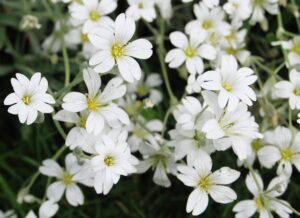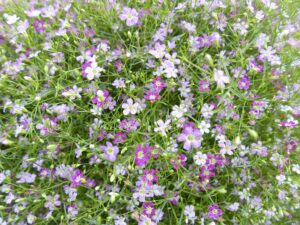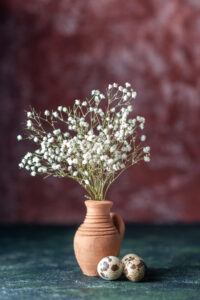Gypsophila flowers commonly known as baby’s breath, is a genus of flowering plants in the family Caryophyllaceae. These plants are native to Europe, Asia, and Africa and are often grown as ornamental plants for their delicate and airy-looking white or pink flowers.
Gypsophila is commonly used as a filler flower in floral arrangements, particularly in wedding bouquets and centerpieces. It is also used in dried flower arrangements and is a popular cut flower for use in vases.
The flowers of gypsophila are typically small and clustered in large, branching inflorescences that give the plant a delicate, frothy appearance. The leaves are small, narrow, and often covered with a fine, silvery down.
Gypsophila plants can vary in size depending on the species. Some species can grow up to several feet tall while others are low-growing and form mats. The leaves of gypsophila plants are narrow and usually have a bluish-green color. They are small and can be either linear or lance-shaped.
Gypsophila flowers are small and delicate, with a diameter ranging from 2-5 mm. They are usually white, but some species can have pink, red, or lavender-colored flowers. The flowers are arranged in large, branching inflorescences that give the plant a frothy appearance. Gypsophila flowers typically bloom in the summer months, from June to August. The blooming period can vary depending on the species and growing conditions.

Overall, gypsophila flowers are delicate and airy-looking plants with small, narrow leaves and small, white, or pink flowers that are arranged in large inflorescences. They are popular for use in floral arrangements and are relatively easy to grow in a variety of growing conditions.
Cultivars of Gypsophila flowers
There are several cultivars and varieties of gypsophila flowers, each with its own unique characteristics and growing requirements. Here are some of the most popular cultivars and varieties of gypsophila flowers:
Gypsophila paniculata: This is the most commonly grown species of gypsophila, also known as baby’s breath. It produces masses of small, white, or pink flowers on tall, branching stems. There are many cultivars of Gypsophila paniculata, including ‘Bristol Fairy’, ‘Snowflake’, and ‘Perfecta’.

Gypsophila elegans: This species produces delicate, airy sprays of small, white, or pink flowers on slender stems. It is commonly used as a filler in cut flower arrangements. There are several cultivars of Gypsophila elegans, including ‘Covent Garden’, ‘Carminea’, and ‘Rosenschleier’.
Gypsophila repens: This species is a low-growing groundcover that produces small, white, yellow, blue or pink flowers on trailing stems. It is often used as a border plant or for edging. There are several cultivars of Gypsophila repens, including ‘Pink Fairy’ and ‘Rosea’.
Gypsophila muralis: This species produces small, pink, yellow or white flowers on short, spreading stems. It is often used as a ground cover or for rock gardens. There are several cultivars of Gypsophila muralis, including ‘Ballerina’ and ‘Splendens’.
Gypsophila cerastioides: This species produces small, pink, or white flowers on prostrate stems. It is often used as a ground cover or for rock gardens. There are several cultivars of Gypsophila cerastioides, including ‘Gnome Pink’ and ‘Alba’.
Overall, there are many different cultivars and varieties of gypsophila flowers, each with its own unique characteristics and growing requirements. By selecting the appropriate cultivar or variety and providing the appropriate growing conditions, gypsophila flowers can be grown successfully and produce beautiful blooms.

Climatic Requirements of Gypsophila Flowers
Gypsophila flowers have different climatic requirements depending on the species, but in general, they prefer cool to moderate temperatures. Most gypsophila species are adapted to grow in dry and sunny conditions. In terms of temperature, gypsophila plants generally prefer cooler temperatures, and they can be sensitive to extreme heat and drought. They can grow in USDA hardiness zones 3-9, with some species being more cold-hardy than others.
Optimum Soil Requirements of Gypsophila Flowers
Gypsophila flowers can grow in a variety of soil textures, including sandy, loamy, and clay soils. However, they generally prefer soils with a lighter texture that allow for good air circulation around the roots. Gypsophila plants also prefer a slightly acidic to neutral soil pH (around 6.0-7.5) and can benefit from occasional fertilization during the growing season with a balanced fertilizer. They can tolerate a wide range of soil types as long as the soil is well-draining. However, they do not like to be waterlogged and are sensitive to overwatering, which can lead to root rot and other problems. Adding sand or gravel to the soil can help improve drainage.
Temperature and Humidity Requirements of Gypsophila Flower
Gypsophila plants thrive in cool to moderate temperatures between 60-75°F (15-24°C) and low humidity levels of 40-60%. They can withstand different growing conditions but are sensitive to extreme heat above 85°F (29°C) and high humidity, which can lead to fungal diseases. Optimal growing conditions are crucial to producing beautiful blooms.
Propagation of Gypsophila Flowers
Gypsophila flowers can be propagated through seeds.
Sow the seeds in early spring, either indoors or outdoors.
Plant the seeds in well-drained soil and cover them with a light layer of soil. Water well.
Keep the soil moist and provide plenty of sunlight for the seeds to germinate.
Once the seedlings have grown several inches tall, thin them out so they are spaced several inches apart.
Water Requirements of Gypsophila Flower
When watering gypsophila flowers, it is important to water deeply so that the roots receive enough moisture. This means watering until the soil is evenly moist to a depth of several inches. It is best to water gypsophila flowers in the morning. Overhead watering, such as using a sprinkler, can lead to wet foliage, which can promote fungal diseases. It is best to water at the base of the plant.
How much Fertilizer is needed for your Gypsophila flowers?
Gypsophila flowers don’t require much fertilizer, but they can benefit from a balanced fertilizer applied once or twice during the growing season. Over-fertilization can harm the plant. Use a 10-10-10 or 12-12-12 formulation or a slow-release fertilizer during the growing season. Apply fertilizer to the soil around the plant’s base, avoiding contact with leaves and flowers to prevent damage.

Problems while Growing Gypsophila Flowers
Gypsophila flowers can be susceptible to various diseases, and insect attacks. Here are some common diseases and pest that attacks on gypsophila flowers and their control measures:
Diseases
Powdery mildew: This fungal disease appears as a white or gray powdery coating on the leaves and stems. It can be controlled by improving air circulation around the plants, avoiding overhead watering, and applying fungicides such as sulfur or neem oil.
Root rot: This fungal disease causes the roots to rot and can lead to wilting and death of the plant. It can be prevented by ensuring good drainage and avoiding overwatering. Fungicides such as copper-based sprays can be applied to infected plants, but prevention is the best control measure.
Bacterial leaf spot: This bacterial disease appears as small, water-soaked spots on the leaves, which can later turn brown and necrotic. It can be controlled by removing infected plant parts and avoiding overhead watering. Copper-based sprays or streptomycin can be applied as a control measure.
Insect Attack on Gypsophila Flower
Aphids: These small, soft-bodied insects feed on the sap of the plant and can cause yellowing, wilting, and deformation of the leaves and stems. They can be controlled by spraying the plant with insecticidal soap or neem oil.
Spider mites: These tiny insects can be identified by their fine webbing on the plant. They suck the sap from the plant, causing yellowing and wilting of the leaves. They can be controlled by increasing humidity around the plant and washing the plant with a strong stream of water.
Thrips: These small, slender insects feed on the flowers and leaves of the plant, causing distortion and discoloration. They can be controlled by applying insecticidal soap or neem oil.
Overall, preventing diseases and insect attacks is the best control measure for gypsophila flowers. This can be achieved by providing good growing conditions, avoiding overwatering, and using disease-free planting material.
Some Interesting Uses of Gypsophila Flower
Gypsophila flowers are widely used in the ornamental industry and have various decorative uses. Here are some of the most common ornamental uses of gypsophila flowers:
Cut flowers: Gypsophila flowers are widely used in the cut flower industry, either on their own or as fillers in bouquets and arrangements. Their delicate and airy appearance makes them popular for wedding bouquets and centerpieces.

Dried flowers: Gypsophila flowers can be dried and used in dried flower arrangements, wreaths, and other decorative crafts. They retain their delicate appearance even when dried, making them popular for decorating homes and events.

Potted plants: Gypsophila plants can be grown in containers and used as ornamental plants in gardens, patios, and balconies. They can also be grown indoors in bright, sunny locations.
Landscape plants: Gypsophila plants can be used as low-growing ornamental plants in rock gardens, borders, and as ground covers. They are also used in larger landscape plants, especially mass plants, to create a soft, romantic feel.
Floral arrangements: Gypsophila flowers are often used in floral arrangements to add texture, volume, and depth. They can be combined with other flowers and foliage to create a variety of looks, from classic and elegant to rustic and whimsical.

Overall, gypsophila flowers are versatile and widely used in the ornamental industry due to their delicate appearance and long-lasting quality. They can be used in a variety of ways to add beauty and elegance to any setting.


